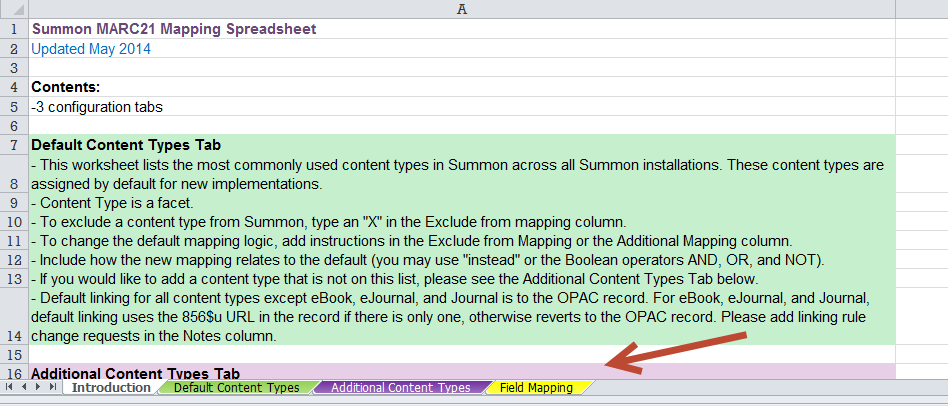Summon: MARC Mapping Spreadsheet, Instructions, and Policy
- Product: Summon
Where is the Summon MARC Mapping Spreadsheet and how do I use it?
Refer to these instructions and guidelines as you in fill out your Summon Mapping Spreadsheet. These are intended to help you understand the fields in the Spreadsheet, by showing default mappings and offering examples of the mapping practices that we recommend. For further clarification on each of the available fields, see the Summon Data Dictionary.
Making changes to your MARC mapping for the Summon service requires extensive development work and quality-assurance testing, so we ask that you bundle your mapping changes for maximum efficiency. Bundling changes also provides us with the opportunity to ensure that all of the changes you have requested work together.
Mapping options are not limited to the defaults on the Spreadsheet. If you would like a particular change or correction, please add it to the appropriate tab in the spreadsheet.
For your library, select the relevant MARC Mapping Spreadsheets to download and view:
Each Summon Mapping Spreadsheet contains the following tabs at the bottom of the spreadsheet: Introduction, Default Content Types, Additional Content Types, Field Mapping, and Location List (CNMARC Mapping Spreadsheet Only). For example:

Introduction Tab
This tab provides a detailed explanation of the different columns in the other tabs. The information on these tabs shows how Summon uses the data elements in your collection. You may decide to use these default mappings or to change them. They illustrate common MARC standards, and where they are deemed most appropriate to appear in the Summon interface.
Field Mapping Tab
Many of the MARC fields are indexed and searchable, but not displayed. This information is found in the Display Location and Facet columns of the yellow Field Mapping tab. You may add or delete MARC fields as appropriate for your catalog records. Please provide instructions in the Changes/Corrections column. Because we use identifiers like ISBN and ISSN for Summon operations to match and merge records, we cannot map canceled, invalid, subsequent, previous, or unrelated values to identifier fields. For the most part, Summon maps MARC fields/subfields without attention to indicators. Indicators can be used, however, if appropriate for your records. For instance, we can restrict URI mappings to use only 856$u with indicators "40."
Default Content Types Tab
Content Type Mapping is a critical piece for discovery purposes. Content Type Mapping is used by the Content Type facet, which appears on the left side of the Summon results page. A facet is a way of viewing selected types of metadata -- such as Content Types, Locations, and Date ranges -- which can then be used to filter results. The Content Type facet shows the most populated Content Types by default and can be expanded by clicking the "more" link at the bottom of that facet:

The green Default Content Types tab in the spreadsheet includes our default mappings and provides the options to exclude a Content Type from mapping (Column C) and to enter an additional mapping (Column D). Please note that at this time we can map only one Content Type per record. These default mappings have recently been updated to include eBook and eJournal mappings. As of May 23, 2014, we are using these mappings for new Summon implementations. If your Summon instance was implemented previously, we assume that you have already had the chance to add any additional mappings. We will not retroactively add these eBook and eJournal mappings unless you specifically ask us to do so.
The list in the Default Content Types tab includes only our default Content Types. Available but unmapped Content Types are listed in the purple Additional Content Types tab. If you would like us to add one of these content types, please include the appropriate mapping for your records in the "Custom Mapping" column.
In order for us to represent your collection information in the Summon service, we map the MARC fields to the Summon schema, which includes a set of defined Content Types. If you request to add a Content Type that does not exist in the schema, product management will review and consider the request.
Location List Tab
This tab allows you to map location codes found in MARC fields to Summon display names. This tab appears only in the Summon CNMARC Mapping Spreadsheet.
Submit the Spreadsheet
Once all of the sections of your Spreadsheet are complete, please send it to us using the Support Portal option at the top of the Support Center. When we receive your Spreadsheet, we'll map your metadata to your specifications and make the changes to your Summon instance. The mapping process can go through several iterations while you make adjustments based on the results.
If you have further questions about any of the mapping instructions or examples, contact us through the Support Portal option up at the top of page.
-
Date Created: 9-Feb-2014
-
Last Edited Date: 28-Nov-2023
-
Old Article Number: 8812

